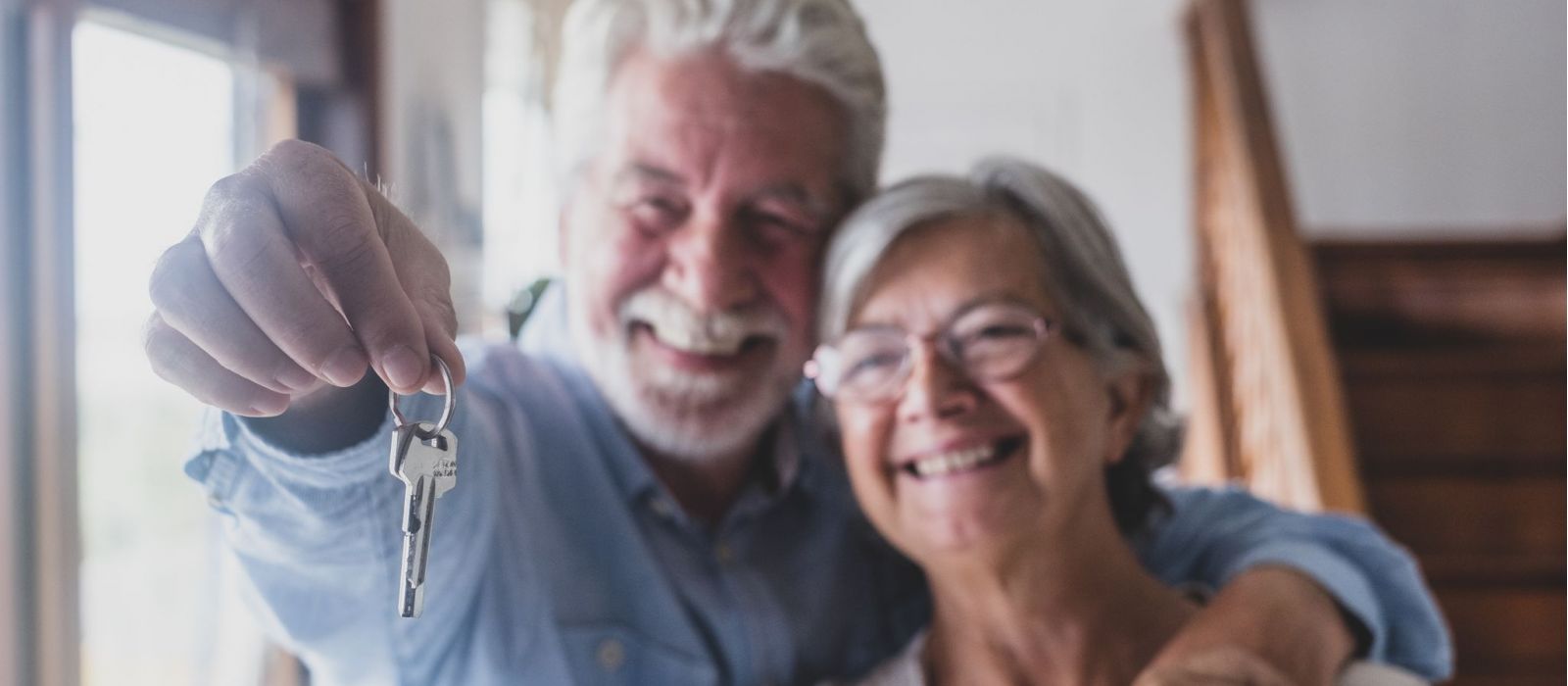How to Choose the Right Senior Living Community
A family decision toolkit
Change is part of life.
Change is part of life.
It’s an overused cliché, yet very true.
However, it doesn’t minimize the mixed emotions that come with major life changes.

Whether it’s deciding on a college, living on your own for the first time, or buying your first house; the process is a journey wrought with highs and lows. Choosing a senior living community is no different. Although, when it comes to this time of life, it may not be with the same mixed emotions.
When is it truly time? What are the options? What do we need? Want? How do we choose? Where do we even start?
This may be due to the misperceptions many have about senior living. Unaffectionately known as ‘the home’ for many, stigmas of the past simply aren’t true today. In fact, senior living communities now more closely resemble resorts on sprawling campuses with comfortable accommodations and plenty of amenities. The environment fosters independence, perhaps even more so than at home. The many opportunities to socialize, exercise and stay mentally active will pleasantly surprise you. As for the cost, that may surprise you too because, in some cases, senior living is less expensive than staying home!
The other part is the journey itself. When is it truly time? What are the options? What do we need? Want? How do we choose? Where do we even start? And once we decide on the senior living community, how do we actually make the transition?
We can help you with it all—from looking at this time as a new beginning to making the decision to moving in. Simply put, it’s everything your family needs to know about choosing a senior living community.

Navigating the Journey
Did you decide to move for a more carefree lifestyle? Are you looking at options for a loved one who now needs more assistance than can be provided at home? The journey is different for everyone. Add in different caregiving roles, family dynamics, budget, location and lifestyle considerations
and you now know why senior living is no longer one size fits all.
That said, everyone’s journey should start in one place – with an honest assessment of your situation to identify what’s working and what isn’t.
Here are some areas to think about and assess: are they currently working, does the family want to manage, and should we get help?
- Meals/Nutrition
- Transportation
- Socialization
- Personal Care
- Medication Management
- Housekeeping/Laundry
- Home Maintenance
- Safety
- Caregiver Stress
Head vs. Heart
How do you make decisions?
Do you list pros and cons and go from there? Do you go with your gut? Somewhere in between? Emotions are said to drive 80% of the choices Americans make, while practicality and objectivity only represent about 20% of decision-making.
When to HALT decisions
HALT is an acronym that stands for Hungry, Angry, Lonely or Tired. If you make decisions when you are one of these things, emotion wins 100 percent of the time!
Source: Psychology Today

Careful Considerations
Whether you’re the one moving or you’re the primary caregiver, when considering a life change of this magnitude it’s crucial to get input from family members. They may offer conflicting opinions, may have thoughts or ideas you haven’t considered, or may affirm your decision. Regardless, everyone should feel valued and heard to foster a spirit of collaboration in the decisions ahead.
As a starting point, each family member involved in the decision-making process should put these considerations in order of importance (1–5). Have everyone complete his or her own, but do them at the same time if possible to align everyone’s goals on what is most important in your search.
| Values and Hot Buttons | Importance to Me | Importance to My Parent |
|---|---|---|
Lifestyles / Amenities / Socialization / Choice |
| |
Care/Wellness |
| |
Safety/Security |
| |
Location |
| |
Price |
|

Prepare for the Talk
If you suspect your loved one will be resistant to the idea of senior living, follow these tips to start the discussion.
-
Do
write down talking points about why it is time to consider senior living to help guide discussion and to help you remember important questions.
-
Do
consult with a professional such as their physician, a case manager, social worker, lawyer, financial advisor or even a therapist or spiritual leader. Input from a neutral party, particularly one your loved one trusts and respects, can go a long way.
-
Do
select time(s) when you and your loved one are free of distractions, pending appointments or to-dos to allow the discussions to flow without rush.
-
Do
make sure to keep the tone casual and positive, asking questions about your loved one’s needs and wants for the future and their concerns.
-
Don’t
dictate a plan to your loved one. You’re trying to create an ongoing, honest discussion about their future, so they should be included in all aspects of the process.
-
Don’t
parent your parent.
Share your concerns, but regardless of how the tables may be turning, it’s important they feel respected and heard as your parent. -
Don’t
feed the fear. It’s important to guide the conversation around your concerns, but in a way that you’re working together to help your loved one live their best life, not scaring them into a move.

Meeting Your Needs and Wants
There are non-negotiables and nice-to-haves in every major life decision—choosing a house, car, college or even a spouse. Senior living is no different! Identifying these early on can help you stay focused on your search so your needs and wants are met as best as possible.
We’ll get you started with a list of commonly requested features. Feel free to add your own, but keep in mind most senior living communities already offer the basics such as meals, transportation, housekeeping, linen service, maintenance and activities.
- Personal laundry service
- Washer/dryer in apartment
- Full kitchen
- Kitchenette
- Storage
- Other
- Multiple dining venues
- Outdoor spaces/walking paths
- Art classes
- Access to spiritual programs
- Intergenerational activities
- Spa service
- Pet friendly
- Other
- 24-hour onsite nursing (LPNS or RNS)
- Overnight nurse on call (care aides onsite)
- Onsite medical (doctors, physical/occupational therapy, dentist, podiatrist, etc.)
- Memory care program
- Special diets
- Fitness centers
- Yoga/tai chi
- Other
- Emergency call technology
- Front desk coverage
- Emergency preparedness plan
- Additional safety technology
- Other

Most Common Fears for Seniors
If you’re considering senior living for your love one, it’s important that you don’t approach the move from a purely practical standpoint. This is an emotional time with common fears that include:
-
Loss of independence
-
Failing health, particularly memory
-
Running out of money
-
Having to leave their home
-
Losing loved ones
-
Having to depend on others
-
Not being able to drive
-
Being isolated and lonely
-
Falling or becoming incapacitated
Take these fears to heart as your family discusses the future together. Showing empathy and patience will provide comfort that you’re on their side, can strengthen your relationship and even help them warm up to the idea of moving.
Playing Up the Plusses
The environment fosters independence
Senior living communities provide just the right amount of support and assistance to help your loved one live life to its fullest.
THE LIFESTYLE IS WORRY-FREE
THE LIFESTYLE IS WORRY-FREE
LONELINESS IS A NO-GO
LONELINESS IS A NO-GO
YOU CAN STILL BE YOU
YOU CAN STILL BE YOU

Levels of Living
Understanding your options
Understanding your options
Senior living communities offer more care and housing options today than ever before. The abundance of choices can be overwhelming if you’re not prepared. Good thing you are! By having your most important considerations and what you want and need identified already, your family will have a much easier time finding the right community.
Ideal for active older adults who require little daily assistance, but seek a vibrant social community without the hassle of chores and home upkeep.
You can typically expect:
- A range of accommodations from condominiums and apartments to free-standing cottages
- Carefree living with restaurantstyle dining, housekeeping, laundry services and transportation
- A variety of social opportunities, activities and clubs
- Amenities that include concierge services, a pool, fitness center, library and onsite beauty and barber salon
Onsite medical care is typically not offered in independent living. If assistance with activities of daily living is needed, or there are serious health issues to manage, independent living may not be the best fit.
Provides housing, onsite care and support with activities of daily living while helping residents maintain their independence and enjoy an engaging, purposeful life. You can typically expect:
-
Personalized care with bathing, dressing, eating and medication as well as certain types of on-site medical care to ensure the right amount of support
-
The comfort of a homelike setting without the worry of home upkeep, cooking, cleaning and yard maintenance
-
Features that include spacious accommodations, 24-hour staffing and security as well as transportation, in addition to amenities such as a pool, fitness center and on-site beauty salon
-
Daily social opportunities through a range of scheduled educational and cultural programs, activities and outings
If specialized care is needed for dementia, incontinence, or other chronic health issues that require round-the-clock care, assisted living may not be ideal.
Specifically designed to nurture and support those with dementia, including Alzheimer’s disease. You can typically expect:
-
Staff specifically trained to assist those with dementia, including Alzheimer’s disease
-
24-hour staffing and layouts that are easy to navigate
-
Therapy, structured brain-health activities and programs with social opportunities
-
Features that include comfortable private or semi-private rooms, housekeeping and laundry service as well as emergency call systems and health monitoring
Offers 24-hour supervised care, a licensed physician or nurse on site, as well as physical, speech and occupational therapists. You can typically expect:
-
Comfortable private or semi-private rooms with round-the-clock care and assistance with daily living
-
Health monitoring and medication management
-
Exercise programs, social opportunities and activities
-
Features such as housekeeping, laundry service, three daily meals, onsite beauty salon and transportation
This environment is ideal for those with chronic health conditions or incontinence, who require dispensing and monitoring intravenous medications and/or who are recovering after a surgery or hospitalization.
For Today and Tomorrow
While communities that stand alone as independent living, assisted living/personal care, memory care or skilled nursing are available, some offer a full continuum of care all on one campus. Rather than having to move from place to place as health needs evolve, being able to stay with friends, in the comfort of familiar surroundings and to have continuity in care provides invaluable peace of mind for our residents and their families.

Figuring Out Finances
PRICING PREVIEW
The best example of what you can expect comes from the Genworth 2018 Cost of Care Survey.Average Monthly Costs, At Home
Homemaker services | Help with household tasks that cannot be managed alone | $4,004 |
Home health aide services | “Hands-on” personal care, but not medical care | $4,195 |
Adult day health care | Social and support services in a community-based, protective setting | $1,560 |
Average Monthly Costs, In Senior Living
Assisted living | Private, one-bedroom | $6,500 |
Skilled nursing | Semi-private room | $7,500 |
Skilled nursing | Private room | $8,500 |
Unlike the types of care above, there is little published data on average monthly costs for independent living and memory care pricing as it varies greatly by geographic location, services and amenities. Typical ranges are as follows.
Independent Living | $5,000 to $7,000 per month* |
Memory Care | $7,000 to $10,000 per month** |
*Seniorhomes.com 2015 Cost Data **Genworth 2015 Cost of Care

Comparing the Cost of Home Versus Senior Living
Make sure you’re comparing the total cost of living at home, not simply your mortgage and rent costs as this has a large impact on affordability. At home, you also pay for food, utilities, home maintenance, property taxes, insurance, entertainment and health care. Factor those costs into your current monthly expenses for a more apples-to-apples comparison with potential senior living costs.
Cost Comparison Worksheet
| Monthly Expenses | Costs at Home | Senior Living Costs |
|---|---|---|
Mortgage or rent |
| |
Caregiving | ||
Property tax and insurance | N/A | |
Home maintenance and repairs | included | |
Lawn care and yard maintenance | included | |
Housekeeping | included | |
Utilities (electricity, gas, registration, repairs) | included | |
24-hour security | included | |
Transportation (insurance, gas, registration, repairs) | included | |
Dining | included | |
Social and Entertainment | included | |
Exercise and wellness | included | |
24-hour emergency alert system | included | |
TOTAL ACTUAL COSTS |
But What’s the Value?
Even if your comparison shows a senior living community may cost more, make sure to keep the positive impact on quality of life in the equation. What is the value of a satisfying social life? What is the worth of rediscovering the cultural and recreational activities you’ve always loved? And remember, there’s no price tag on peace of mind.
Four out of five adults underestimate the costs of home health care with the average American underestimating the cost by almost 50 percent, according to the Genworth Long Term Care/ Caregiving Online Survey.
The Conundrum of In-Home Care
Care in the home can be difficult to calculate as it varies considerably due to factors such as location, type of care and length of time. For comparison, let’s look at hourly rates for types of care based on national averages.
| Type of Care | Hourly Rate (24-Hour Care) | Monthly Estimate (30 Days) |
|---|---|---|
Homemaker services | $21 | $15,120 |
Home health aide services | $22 | $15,840 |
CNA (medical) services | $11 | $7,920 |
LPN (medical) services | $20 | $14,400 |
RN (medical) services | $27 | $19,400 |
Care provided by home health aides is costlier than ever. Genworth research points to these factors for continuing increases:
-
Low unemployment
-
Wage pressures
-
Regulatory changes
-
Labor shortages
-
Sicker patients
-
Employee retention challenges

Building Your Budget
Now that you better understand the cost and value of senior living, let’s discuss how you can prepare financially. While every family’s circumstances are different, there are three general steps you should follow in budgeting for senior living.
1
Gather and organize financial documents for yourself or your loved one such as:
- Bank and brokerage account information
- Deeds and mortgage papers
- Insurance policies
- Monthly or outstanding bills
- Pension and other retirement benefits
- Social Security payment information
- Stock and bond certificates
2
Discuss putting a financial plan in place while you’re discussing what you want in a senior living community. Talk about your wishes, needs and goals (or those of your loved one) as well as how to handle ongoing financial duties such as paying bills, managing benefit claims, making investment decisions and preparing tax returns.
3
Consider consulting a financial advisor and/or estate planning attorney who specializes in elder care and/or long-term care planning to discuss:
- Insurance options
- Pension, retirement benefits and personal property that may be potential income
- Programs in which you are eligible
- Potential tax deductions
- Analyzing yours or your loved one’s investment portfolio with long-term needs in mind
Options to Offset the Cost
Veterans Aid & Attendance Benefit
LONG-TERM CARE (LTC) INSURANCE
LIFE INSURANCE CONVERSION

Common Misperceptions
Many people incorrectly assume that Medicare, Medicaid and/or their health insurance will cover senior living.
- In a nursing home for a maximum of 100 days.
- At home if you are also receiving skilled home health or other skilled in-home services.

Comparing Communities
Now that you have a better idea of what type of senior living community might be the best fit, it’s time to find the right place for you. To say not all communities are alike is an understatement. It’s crucial to learn all you can up front.
Dig in Online
Most families start gathering information online to research apartment styles, floorplans, services, amenities and level of care (independent living, assisted living, skilled nursing, memory care). It’s helpful to search by geographic location initially to narrow your choices, particularly if you don’t have specific communities already in mind.
A good website will often offer virtual tours and downloadable content such as brochures, sample menus, activity calendars and floor plans as well as resources such as blogs and guides. “Starting at” pricing should also be available either on the website or in the brochure.
Reach Out
Contact communities you’re interested in to have a personal conversation with a community representative. It’s a good way to ask more detailed questions, and get a sense of the community culture.
Schedule a visit
Next, identify the communities you’d like to tour. Don’t forget to bring your lists of what’s important to you along with your questions to keep you from being overwhelmed or distracted by what the management wants you to see.
Ask Around
Bonus Tip
During your visit, talk with the residents about their daily life in the community as well. If you can’t speak with them directly, observe their behavior—do they seem happy and well cared for?
Double Bonus Tip
Include other family members or decision makers in this process, just like you did in the beginning. And if you’re choosing options for a loved one, make sure to bring them to visit as well to get their input.

Making the Transition
Once you’ve chosen the community it’s time to plan the move. Even though your family has agreed that senior living is best, there’s still likely to be a great deal of trepidation about what to expect. It’s important to include the community at this point of the process. They will be more than happy to help ease the transition for all of you!
It’s important to include the community at this point in the process.
Here’s how:
- Ask what resources they recommend such as realtors, moving companies and professional downsizing specialists.
- Arrange an in-home visit from the community. A staff member will visit, get to know your loved one, learn their needs, likes and desires and answer any questions you may have.
- Visit the community often with your loved one to have a meal, participate in activities and get to know the staff as well as your new neighbors.

What to Expect
Once you put down a deposit, an assessment will be scheduled (unless you are moving into independent living) to ensure the community can provide you with all the care required. The assessment also determines the additional costs for personal care. There are communities that include some care within the monthly fee and others separate rent and care. Every state regulates senior living differently, and the state determines what care can and cannot be provided.
Be sure to ask what paperwork is needed for this meeting.
- A physician’s clearance form
- Insurance, Medicare and Social Security cards
- Chest X-ray or a negative TB test
- Legal documents such as healthcare proxy, power of attorney, etc.

Downsizing Tips
Take it Slow
Sort it Out
Find a Way to Let Go
Bring Friends
What to Bring
-
Comfort itemsBring your favorite blanket, throw or pillows along with sheets, a bedspread and a clock.
-
Personal CareMake sure you have a toothbrush, toothpaste, hairbrush and comb as well as a shaving kit for men or cosmetics for women. Include any other personal grooming items in addition to several bath towels, hand towels and wash cloths.
-
ClothingBring clothes that are comfortable to wear and easy to get on and off. Also bring rubber-soled shoes to help prevent falls. Don’t forget undergarments, pajamas, socks, robe and slippers as well as a light sweater or jacket.
-
FavoritesDon’t forget favorite snacks, books and/or music to make it feel even more like home.

Moving Day
-
Have everything readyAll new resident paperwork should be complete and you’ve oriented yourself to the community and its policies.
-
Set up your spaceIt’s one of the first things you should do; you’ll feel more at home and will be ready to welcome all those new neighbors and friends.
-
ConnectSenior living communities typically have new resident ambassadors (or some type of buddy system) to help you feel welcome. They’ll pair you with a person or persons who share similar interests or backgrounds to show you the ropes.
-
Pick their brainKeep in mind, the residents have been where you are and may have some tips from when they first moved. And it’s a great conversation starter!
-
Enjoy your first mealEven if you’ve visited prior, that first meal as a resident can be stressful. Have a family member join you, sit with your resident ambassador or both to take the edge off as you meet and talk with new friends and neighbors.
